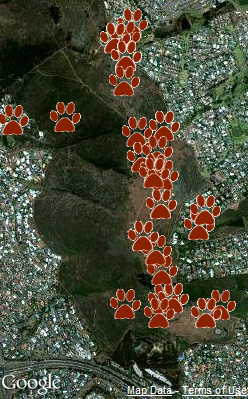 |
| A clutch of 15 golf balls I picked up at Tygerberg Nature Reserve |
This weekend I picked up 7 balls while doing my camera trapping rounds! I'm starting to think that maybe they are some sort of disguised tortoise eggs? Maybe the tortoises have started to naturalize to the urban environment and found that mimicking golf balls some how increased the survival rate of their eggs... Now, at first that might sound ridiculous, but if you think about it... Golfers often carry many excess balls in their bag. The bag makes an excellent incubator. A golfer will usually select the best ball in the bag when they need one. Now say the egg looks enough like a ball to fool the golfer, but does not look appealing enough to justify actually using the ball? Mmmm... Maybe I should try incubating one of them and see what hatches...
I have a few slightly more extravagant theories, but maybe I should take a sharp U-turn and bring the discussion back to reality: And what better way than talking about Death.
 |
| A little snake that didn't survive the fire |
I stumbled upon this casualty of the veld fire while looking for camera trap locations about a month ago. It is a little snake that could not escape because it was stuck under the stone. This is the only fire casualty I could find, except for a couple of fried eggs.
OK... before I cock to many eyebrows... The reason for this post: a Cape Grysbok.
 |
| A male Cape Grysbok (Kaapse Grysbok - Raphicerus melanotis) sneaking along |
This is a pretty nice photograph I got from the Cuddeback. The first week the camera only got Bontebok and Porcupine pictures, but I decided to leave it out a little longer in the hopes of getting the resident Grysbok. I've photographed Grysbok in the same area before, but a large section of this part of the reserve was burnt.It is good to know that it is still around after the burn.
You can clearly see the white/grey speckles that gives the animal it's name, I guess it is because it looks like it is turning grey. Grysbok translates to Grey Buck. Only the males carry horns.
The Cape Grysbok is more or less endemic to the Fynbos region. There aren't really any other medium-large mammal species that are endemic to this region, making the Cape Grysbok somewhat special.























